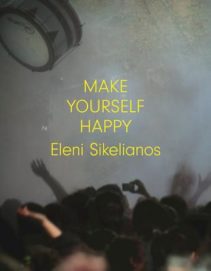 Eleni Sikelianos
Eleni Sikelianos
Coffee House Press ($18)
by Linda Lown-Klein
In this, her seventh collection of poems in an oeuvre that includes a long eco-poem, two hybrid essays/memoirs, and six other books of poetry, Eleni Sikelianos writes whimsically about how to "make ourselves happy" while sounding a strong cautionary note about the risks to the biosphere if we focus solely on our own well-being.
Chiding us for our selective perception, she writes:
The sounds of
sirens outside the window are
gay to the ear that tends
to hear what it needs
to make itself happy.
Her poems urge us to acknowledge our responsibility to the universe, as when, after killing a raccoon that "looked so evil," the speaker wonders: "What if it were The / Last Animal on Earth?" Wary of the risks of human self-absorption, the speaker in another poem says: "I would not wish to live anywhere, ever, where everybody's always / happy.”
In a world where "Everybody's hoarding / Everybody's barfing up / the world's extra energy,” Sikelianos writes poignantly about the determination of the animals to hold on:
They will never be done Never be
done dancing If we wipe them
from the face of the earth
they will never be done being
part of it making the world with their
sounds & feet & hoovesuntil they are done dancing the
animals' ghost dance &
then they will be done.
Throughout this three-section book, Sikelianos deconstructs and reconstructs words and sounds, stretching and shortening them to create new meanings. "put the letters in the tin can and rattle them around," says the speaker. Elsewhere, burrowing down to basics, she says: "I look up at the sky, scan / for atoms, colors, vowels."
Imagery from the biosphere abounds. This is a world where all is fluid and objects morph into one another: "A seagull goes crashing / right into a cloud / because it wants to be a cloud / . . . The clouds being hills once hug the hills close.”
That same dreamlike quality obliterates boundaries of time and place; in this book where nouns come alive as verbs and which is rich with references to mythology, psychology, philosophy, science, and literature, Sappho can emerge from the past to step right into the contemporary world of the poem:
What I mean and what I meadow
What I want and what I winnow
When I see it it's Sappho biting into a sesame seed
She arrives right through the centuries
Walked from Mólivos to Pétra
Bright blossoms along the way
Green fields seaside and some rundown stone houses among the hotels
Sappho, how's it going
Often, the poetic act itself is the subject, and on one page we meet the poem in the flesh:
I am walking down a narrow street
I leap
into your arms
your arms are the poem
and I am the poet
how wonderful
to meet like this
right on the street, stranger!
Sikelianos leaves us much to ponder and urges us what best to heed, if we want to truly learn "how to live":
"ONE WAY" into these woods
the sign says and
"no parking" as if
I'd want to park my carc-
ass in a patch of snow
a fuzz of white pine sapling says yes yes
in the wind then
no no! when it says yes
and when it says no make a
go of
it. It
is how to live. (35)
Enhanced by its illustrations and well researched, Make Yourself Happy is committed to seeing language in all its vibrancy make a plug for the universe.
